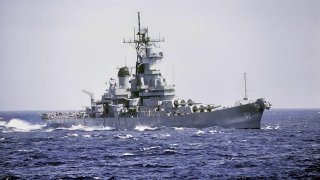Iowa-Class Battleship USS New Jersey Is Close To Making a Big 'Comeback'
The USS New Jersey, an iconic Iowa-class battleship decommissioned in 1991, is set for a significant $10 million overhaul after serving as a museum piece. This renovation includes routine maintenance, repairs, and repainting for the first time in 32 years, aiming for completion before Memorial Day to enhance its appeal during peak tourist season.
Summary: The USS New Jersey, an iconic Iowa-class battleship decommissioned in 1991, is set for a significant $10 million overhaul after serving as a museum piece. This renovation includes routine maintenance, repairs, and repainting for the first time in 32 years, aiming for completion before Memorial Day to enhance its appeal during peak tourist season. Commissioned in 1943 and with a distinguished service history in World War II, the Korean War, and the Vietnam War, this initiative ensures the "Big J" continues to educate and inspire as a floating museum, preserving its legacy for future generations.
USS New Jersey Battleship to Undergo $10 Million Revamp Before Memorial Day
Despite being decommissioned 24 years ago, the USS New Jersey, an Iowa-class battleship, is back in the news cycle. The renowned ship, nicknamed “Big J,” has been quietly serving as a museum piece – but is not set to receive a $10 million overhaul.
“The battleship will undergo routine maintenance, repairs, and repainting for the first time in 32 years, a job that will cost $10 million,” the Maritime Examiner, reported. “That task is expected to take 60 days following which the ship will be towed back to Camden in time for Memorial Day and the peak tourist season.”
A Storied History
The USS New Jersey was commissioned in 1943, as the second Iowa-class off the production line. Immediately, the New Jersey was sent west, from her construction site at the Philadelphia Naval Yard, to join the fight against Imperial Japan. The New Jersey’s contributions to the Second World War are heralded; she earned more battle stars for combat actions than any of the other three Iowa-class battleships. New Jersey earned her battle stars in an assortment of different skirmishes, including, shelling targets on Guam and Okinawa, and screening aircraft carriers that were conducting raids in the Marshall Islands.
The surrender of the Japanese, which concluded World War II, did not mark the end of New Jersey’s service life. Rather, New Jersey served two tours in Korean War. Off the coast of Korea, New Jersey again proved valuable, using her 16-inch guns to extend the range of United Nations land artillery, firing upon coastal targets in preparation of ground actions.
When the Korean War (de facto) concluded, the New Jersey was decommissioned and transferred to the reserve fleet. But, cutting against orthodoxy, being decommissioned would not be the end of the line for the New Jersey.
A Phoenix
As the US sustained heavy aircraft losses during the opening years of the Vietnam War, Secretary of Defense Robert McNamara initiated a study to determine ways to alleviate the heavy losses. The study eventually led to the recommissioning of the New Jersey.
One of the reasons the New Jersey was deemed fit for recommissioning is because she’d had an extensive overhaul just before being retired, and as such, was in much better condition that her Iowa-class peers. And once New Jersey was recommissioned, she became the world’s only active battleship, a floating heirloom of a bygone era in twentieth century warfare. Naturally, New Jersey became the only Iowa-class battleship to fire upon targets during the Vietnam War.
Once the last helicopter withdrew from Saigon, the New Jersey was decommissioned again – yet again, the decommissioning would not be the end of the road; President Ronald Reagan’s effort to expand the Navy, in the early 1980s, to 600-vessels, would lead to the New Jersey’s second recommissioning. The final tour would be brief, however, with the New Jersey being decommissioned – for good – in 1991. Ever since, the New Jersey has served as a museum piece.
Overdue for repairs
“We’re way overdue and are moving forward now because it will be more expensive every year we wait,” said Marshall Spevak of the Homeport Alliance, in reference to the New Jersey. Spevak added that the New Jersey has been overdue, specifically, for 12 years according to the US Navy’s prescribed maintenance guidelines, which call for dry-docking every 20 years.
Yet, with the proper maintenance, the New Jersey may be able to continue serving as a museum piece for the foreseeable future.
About the Author: Harrison Kass
Harrison Kass is a defense and national security writer with over 1,000 total pieces on issues involving global affairs. An attorney, pilot, guitarist, and minor pro hockey player, Harrison joined the US Air Force as a Pilot Trainee but was medically discharged. Harrison holds a BA from Lake Forest College, a JD from the University of Oregon, and an MA from New York University. Harrison listens to Dokken.


